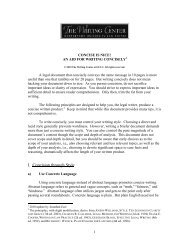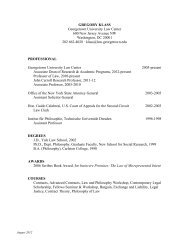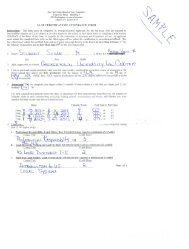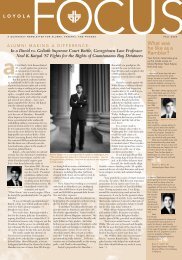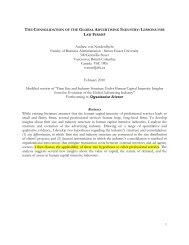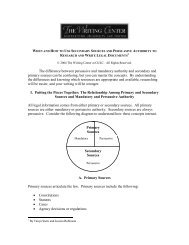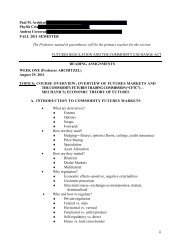Date: April 12, 2013 Topic: The Shrinking ... - Georgetown Law
Date: April 12, 2013 Topic: The Shrinking ... - Georgetown Law
Date: April 12, 2013 Topic: The Shrinking ... - Georgetown Law
You also want an ePaper? Increase the reach of your titles
YUMPU automatically turns print PDFs into web optimized ePapers that Google loves.
1<br />
DECONSTRUCTING BIG LAW<br />
<strong>The</strong> Future Market for Corporate Legal Services<br />
Preliminary Results<br />
by<br />
Molly Selvin 1 and Patrick M. Hanlon 2<br />
<strong>The</strong> <strong>Shrinking</strong> Pyramid: Implications for <strong>Law</strong> Practice and the Legal Profession Symposium<br />
<strong>Georgetown</strong> University <strong>Law</strong> Center<br />
<strong>April</strong> <strong>12</strong>, <strong>2013</strong><br />
Abstract<br />
<strong>The</strong> legal industry is in transition. A generation of explosive growth in the market for corporate legal<br />
services has ended, and while many big law firms remain highly profitable to their owners, revenues are<br />
stagnant, jobs are increasingly insecure, and the demand for new lawyers is at low ebb. Stories<br />
announcing the demise big‐firm law practice have made the New York Times front page and draw<br />
almost obsessional coverage in legal trade publications.<br />
Though the law firm “pyramid” is under tremendous stress, preliminary results from a multi‐year<br />
Stanford <strong>Law</strong> School project on the future of the legal profession also reveal a more diverse—and<br />
somewhat less dire—picture of the legal services industry.<br />
<strong>The</strong> Stanford legal profession project aims to understand the changes occurring in the market for<br />
corporate legal services and their implications for legal education and legal careers. Our research<br />
encompasses both purchasers and suppliers of legal services. <strong>The</strong> people we have interviewed to date<br />
were candid and thoughtful, and our interviews comprise a rich source of qualitative data.<br />
First of all, these data suggest that that the industry’s financial pressures are neither felt uniformly<br />
across the legal industry nor are they always as acute as often portrayed. While corporate clients have<br />
for years tried to avoid excessive costs, this often does not result in the relentless cost‐cutting and<br />
churning of firms postulated in the literature. Corporate counsel often hire what they regard as the best<br />
lawyers (or sometimes firms) for the job with only limited consideration of cost. This is often due to the<br />
impossibility of replicating outside counsel’s knowledge of the client and its business. By the same<br />
token, despite growing corporate interest in alternative to big law – LPOs, contract lawyers, e‐discovery<br />
and other technology vendors, and even firms that provide highly sophisticated lawyers on a temporary<br />
basis – these alternatives so far enjoy only modest market participation. <strong>The</strong>y have a long way to go to<br />
realize their full potential. Second, cost pressures have allowed some lawyers to capitalize on the<br />
1 Research Fellow, Stanford Center on the Legal Profession, Stanford <strong>Law</strong> School; Associate Dean for<br />
Interdisciplinary Programs and Adjunct Professor of <strong>Law</strong>, Southwestern <strong>Law</strong> School.<br />
2 Research Fellow, Stanford Center on the Legal Profession, Stanford <strong>Law</strong> School and former lecturer at Berkeley<br />
<strong>Law</strong> and partner at Goodwin Procter LLP.



